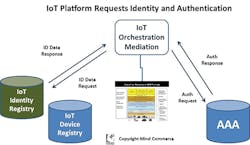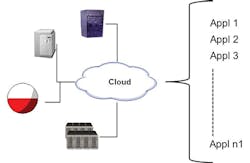Fundamentals of Programmable Telecom
Telecom Application Programming Interfaces (API) have been around for years. Why do network professionals need to know about Programmable Telecom (and Telecom APIs) now? What impact does APIs have on your job?
The role of Programmable Telecom and APIs are evolving to support increasingly more than consumer-oriented communications, applications, commerce, and digital content. This evolution extends beyond API support of B2C and B2B services for traditional telecommunications applications. It serves a larger role for network service providers in intelligent solutions for enterprise as well as Internet of Things (IoT) systems and networks. (See Figure 1.)
Figure 1. Next-Generation CSP Assets Driving Telecom API Usage (Source: Mind Commerce)
The deployment of 5G accelerates this Programmable Telecom evolution as APIs leverage the associated capabilities for operational improvements within IoT networks and unified communications. This product evolution requires network professionals to fully understand the impact on Telecom APIs on their business and operations.
This article summarizes what network professionals need to understand about Programmable Telecom and their involvement as telecom and IT become more unified.
A Programmable Telecom Overview
Programmable Telecom is much more than APIs. It refers to technologies and solutions that enable independent development of applications which leverage carrier data and networks. Electronics are considered programmable if they can take action based upon instructions from software. This software may be localized, remote, or a combination of both.
Programmable Telecom offers many types of software development options that leverage network access and data. These tools include Application Programming Interfaces (API), Cloud Computing (hosted telecom services), Communications Platform as a Service (CPaaS), Unified Communications as a Service (UCaaS), Graphical User Interfaces (GUI), Open Source Software and Software Development Kits (SDK).
Telecom APIs capitalize on existing network infrastructure to create a vast array of business opportunities for carriers worldwide. These APIs allow carriers to disseminate a wealth of internal information or resources to third-party applications.
Figure 2. Cloud Services and APIs (Source: Mind Commerce)
Cloud-hosted services helps the network operators improve their services and gain a competitive edge due to the cloud’s ability to enhance agility and efficiency compared to conventional corporate IT infrastructures. (See Figure 2.)
Cloud computing provides these benefits to the telecom industry:
• Improves quality and performance of services.
• Allows independent device and network access to communications and IT services.
• Mitigates upfront costs while boosting total cost of ownership.
• Offers dynamic scalability, real-time resource provisioning, and a utility-based payment model for billing.
The Telecom market is governed by stiff competition between carriers who are struggling to meet the ever-increasing demands for various networking applications and services. Consumers of telecommunications services require a wide spectrum of services irrespective of their devices and locations. Therefore, network operators are seeking efficient and affordable alternatives for delivering IT services in response to consumer demands.
In offering network services, optimization of network is an important carrier objective. The network is a vital asset with strategic significance to the success of the carrier. Networks are the main source of income and expense to the carrier, and have direct impact on the carrier’s profitability. Cloud computing offers the network operators a solution to extract optimum value from their existing networks.
Cloud computing offers carriers the capability of providing application delivery services that are web-based. This expands carrier connectivity and service offerings, and improves their value chain.
Cloud-hosted services broadly includes Software as a Service (SaaS), Platform as a Service (PaaS), Infrastructure as a Service (IaaS) and Communications Platform as a Service (CPaaS). CPaaS is a newer cloud service offering which focuses solely on hosting enterprise communications-enabled applications/services for real-time messaging, voice, and video, applications. CPaaS enables developers to add real-time communications features to their own applications without needing to build backend infrastructure and interfaces.
While GUIs represents a visual way of interacting with a computer using items such as windows, icons, and menus, used by most modern operating systems, Telecom API software development tools with GUI interfaces enables faster and more efficient creation and deployment of communications-enabled applications.
Historically, Programmable Telecom solutions were largely proprietary and application-specific. With the evolution of Programmable Telecom and its business models, carriers need to provide telecom application developers Open Source Software APIs to develop applications. With open APIs, services can be developed to create new innovative solutions which reflect more complex enterprise needs. As an example, various healthcare services would be combined using open APIs, which provide the standard interfaces to connect the dissimilar domains to ensure seamless customer experience.
5G and APIs
With the advent of 5G, communication services APIs will play a key role in development of industry verticals and cross-vertical applications. Open APIs are vital to the creation of next-generation platform solutions.
TM Forum’s (Open APIs) and Global System for Mobile Communications Association (GSMA) APIs are taking the lead in defining Telecom API standards. The Open APIs offer the operators separation of payload specification from the API operations and allow the APIs to be used in many situations. Primary quantifiable benefits include a dramatic reduction in partner onboarding time from a few months to weeks, as well as new revenue channels created through developer portals.
A Software Development Kit (SDK) is a set of packaged software development tools that allows developers to create applications for a certain software environment, software framework or hardware platform (i.e., computer system, video game console, operating system or similar development platform). SDKs are increasingly targeting CPaaS-based network-based platforms.
InvisiLight® Solution for Deploying Fiber
April 2, 2022Go to Market Faster. Speed up Network Deployment
April 2, 2022Episode 10: Fiber Optic Closure Specs Explained…
April 1, 2022Food for Thought from Our 2022 ICT Visionaries
April 1, 2022Unified Communications (UC) Services
As you are aware, Unified Communications, or UC, is a product or set of products (messaging, voice, audio, video, etc.) that provides a consistent unified user interface and user experience across multiple devices and media types. UC allows a user to send a message on one medium and receive the message on another medium (e.g., one can receive a voicemail message and choose to access it through e-mail or a cell phone).
UCaaS provides unified communications services from the cloud. UCaaS services allows companies the option to shift their telecommunications funding from a capital investment (CapEx) to an operating cost (OpEx). The operating cost option allows companies to increase or decrease their communications services, without the need for capital.
The growing sophistication of enterprise unified communications means that companies must invest not only capital, they must invest more in support costs required to support UC services and more in their IT staff in order to be able to support UC.
Using UCaaS allows companies to optimize their telecommunications infrastructure and support costs by adding or removing UC services and platforms. It also allows companies to use the latest telecommunications features and versions with no capital funding outlays.
Telecom App Development Design Considerations
Developing Telecom Apps, developers need to consider, and design for, 3 critical things:
1. Security
Most modern Telecom API products offer adequate security support to provide network firewalls, AAA (Authentication, Authorization, and Accounting/Auditing), IP network Encryption protocols, and intrusion detection systems.
2. Data Privacy
Developers not only have to design for data security, they must also consider Data Privacy and the issues of data ownership, data rights (who can do what with the data), data custody, data care, and data integrity.
The ability to track data from cradle to grave becomes an important means of determining ownership, and who is doing what to and with the data. This ensures data integrity as well as managing service level agreements, identity, and digital rights.
3. Interoperability
One of the key issues with Program Telecom is interoperability. This is especially the case with telecom APIs as there are so many ways to access information. Trying to support them would be prohibitive.
Programmable Telecom and the Enterprise
There is a considerable amount of discussion about how Programmable Telecom will be used in consumer mobile services. However, Programmable Telecom provides a variety of value-added scenarios that will benefit the enterprise. This offers a bigger value chain to the market.
We already mentioned how Programmable Telecom will be a key component in creating enterprise IoT solutions.
Another example is telephony APIs being integrated with enterprise APIs to create an API of greater value to the enterprise than either API alone.
An example of this is the integration of Telecom API providing telephony presence, location, and identity, information with credit bureau information API. This API could be used to prevent identity theft ,and to significantly reduce fraud scores for purchases, which is especially important for big ticket item purchases.
Markets for Today and Tomorrow
Infrastructure and device vendors are developing new and unique roles for themselves within the Programmable Telecom Market, by positioning themselves as enablers of new business models between carriers, content producers, and application developers.
Carriers are migrating various services to the cloud to take advantage of the data they own. This data (not subject to any contravening data protection regulation), includes information such as the location of subscribers, service preferences, and billing relationships, all of which simplify and enhance the creation of integrated applications that combine the functionality of service provider networks with Web-based capabilities.
Carriers are implementing cloud products and services to make these sorts of assets in their network available to Web developers, application, and content, providers through a secure "exposure" layer. The intent being that service providers can monetize their capabilities by allowing developers to access functions such as billing, location, and connection, optimization and add them to their applications.
For many larger Telecom API vendors, a substantial proportion of Telecom API revenue continues to be generated from SIP Trunking in support of their client’s VoIP, UC, and other IP-based communications apps and services.
However, many smaller players are innovating in areas that have high growth potential such as analytics data, device information, edge computing, and number management for calls, data, and subscribers.
As mentioned earlier, an important service area for enterprise is UC in the cloud. Carriers are facing increasing pressure to provide a greater variety of high-quality enterprise communications and collaborations solutions. Programmable Telecom allows carriers to provide value-added offerings such as team collaboration and telepresence to UC service offerings.
Emerging technologies such as robotics and business automation will create the following markets for Programmable Telecom:
• IoT represents a huge and largely untapped market for Programmable Telecom vendors (especially once 5G can be fully leveraged). More specifically, carriers will function as the orchestrator/mediator within the IoT ecosystem. Uniquely positioned as owner of the primary network to be used for IoT, and provider of data services for humans and machines alike, carriers could provide various critical services such as IoT authentication, authorization, and accounting. This will include use of Programmable resources to help manage IoT related access control, permissions, and usage tracking.
• Mobile Edge Computing (MCE) will allow carriers to leverage Telecom APIs in support of many edge-computing-use cases as MEC is rolled out to optimize LTE, 5G, and IoT. Many MEC-use cases will require support from multiple Telecom API categories such as Location, Presence, Subscriber Data, and QoS, in support enterprise apps, services, and data analytics.
• While many Artificial Intelligence (AI) capabilities will be embedded within other areas (such as platforms, devices, semiconductors, etc.), AI will also be closely associated with end users, creating an opportunity for Program Telecom vendors to provide resource support for many AI supported use cases. This will include basic support for AI, such as user verification, as well as more advanced functionality, such as identifying resource usage and behaviors among a closed user group, such as an enterprise collaboration team.
Like this Article?
Subscribe to ISE magazine and start receiving your FREE monthly copy today!
Summary
The role of Programmable Telecom is evolving within the Information and Communications Technology (ICT) sector to support increasingly more than consumer-oriented communications, applications, commerce, and digital content. This evolution extends beyond traditional API support for traditional ICT apps and services towards a larger role for network service providers in intelligent solutions for enterprise, as well as Internet of Things (IoT) systems and networks.
About the Author







